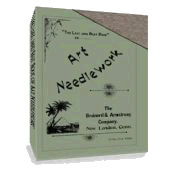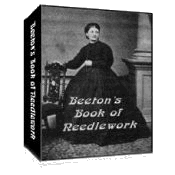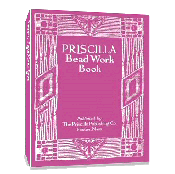[]Subscribe To This Site
Victorian Christmas Household Decorations
Victorian Christmas household decorations are very important to anyone who wants to have a truly Victorian Christmas. The best source of how to recreate an impressively Victorian Christmas is to see how Victorian ladies accomplished that.
The easiest and most accurate way is to see what was written about the subject for women during that era. The following was published inCassell's household guide: being a complete encyclopaedia of domestic and social economy and forming a guide to every department of practical life, dated 1869. It will give you an excellent idea on how home decoration for Christmas was done.
Victorian Household Decorations for Christmas
Ivy-ribbon. — This will be found most useful, either for borders to scrolls bearing mottoes or texts, or for forming devices generally. It is best made by cutting old newspapers, or sheets of waste paper into long strips, about two inches wide, and upon these sewing, with black cotton, ivy-leaves stripped from their stalks. These should be sewn on so that no part of the paper can be seen when the strips of ribbon are nailed upon the wall, and care should be taken to have the edges as level as possible, without being too formal. Of course, holly-leaves would answer the purpose equally well, but they are not so pleasant to work with as ivy, and laurel is somewhat too heavy in appearance, except when used at a considerable height from the ground.
Ground for Scrolls. — The best ground for scrolls is paper — although glazed calico is sometimes used — and this may be of any colour to harmonise with the general appearance of the room, or to please the taste of the decorator. Generally, however, the common cartridge paper will be found to have as good an effect as any. This should be cut — if the scroll is intended to be at any distance above the eye — into strips about a foot wide, and as long as the sheet of paper will allow; while, where the ribbon or scroll folds over so as to show its reverse side, a coloured paper should be used. Orange, crimson, or blue paper will be found to relieve the white with good effect.
Letters. — These are best cut out of coloured paper, and although the taste of the present day inclines to everything medieval, we think, for household decoration, that more modernised letters are preferable, from their being far more legible to the majority of readers, whilst, at the same time, they possess sufficient quaintness and ornamental character. It will be found best to first cut out an alphabet in cardboard, by which means it becomes a mere mechanical labour of a few minutes to mark out on coloured paper a considerable number of letters, and by doubling the paper twice, four letters may be cut out at a time. The height of the letters should be from two to three inches less than the width of the scroll, in order to allow of the ivy ribbon being brought sufficiently over its edge to effectually conceal it.
The colour of the letters will be a matter of choice; from experience, however, we prefer for the ordinary letters of the motto or text a dark blue, purple, or black, with crimson or red for initials, or sometimes for whole words which seem to require special prominence. If a gold initial be desired, it would be well to place it upon a coloured ground — blue is, perhaps, best — for the sake of relief. We prefer the white ground generally, because it admits of the use of more colours in the lettering; but we have seen very nice effects got by putting white letters on a blue ground. In all cases of temporary decorations we advise cutting the letters out of coloured paper rather than painting them, as-being more simple and expeditious, while the effect is often better, owing to the greater brilliancy of the colours.
Scarlet Tape. — This will be found very useful, and to have a good effect in conjunction with the ivy-ribbon, and is itself useful for forming the lines of diaper patterns on plain walls. In operation it will be found advisable, when the letters are cut out, to lay the whole scroll or design out on the floor, and then to arrange the letters loosely in their places. When properly arranged and spaced, apply a little gum or paste to each one separately, and stick it down smoothly in its place. The scroll will afterwards be fixed on the wall with a few fine tacks, and the ivy-ribbon nailed over its edges, thus forming a border. Afterwards, by means of the scarlet tape, a red line may be drawn above and below the letters. We have given an example of a text made in this manner. The scroll is a ribbon made of white cartridge paper, with a crimson or blue reverse, according to the colour of the wall upon which it is fixed: the letters generally dark blue, purple, or black, with crimson or deep red initials; the shield, if the room be papered with crimson hangings, blue, charged with an "open hand" (the badge of courtesy and hospitality) in gold ; the whole bordered with ivy- ribbon.
In this way scrolls may be made for any room with suitable mottoes; as, for an entrance -hall, "Welcome;" for a ballroom the well-known line from Byron would be appropriate: — "On with the dance, let joy be unconfined;" — or from Shakespeare, for a room on the occasion of old family gatherings: "This day we keep an old-accustomed feast."
It will frequently be the case that, on the occasion of larger meetings of friends, concerts, lectures, &c., schoolrooms or even barns may require to be decorated, in order to make their appearance for the time harmonise with the amusement or object of the evening. For rooms such as these more decoration is required, and generally better effects can be obtained, as there are no paperhangings or cornices to be injured by the driving of nails, &c., and the decorator is in consequence comparatively untrammelled.
An almost unlimited quantity of ivy-ribbon will always be found useful, if not absolutely necessary, and one of the best effects we have ever seen was obtained by merely diapering the walls with a plain lozenge diaper of ivy-ribbon, with a large flower in each lozenge, and a smaller one at the intersection of the strips of ivy-ribbon. As the walls of these rooms are generally of a light colour, the flowers in the centre of the lozenge should be of dark-coloured paper, while for those at the intersections of the ivy-ribbon, nothing is better than white, pink, or orange. The breadth of the lozenge-spaces should depend upon the size of the room, and may vary from one foot to two; the lines of dark ivy-ribbon may, if desired, be relieved with lines of scarlet tape.

Flowers for Diapers. — Although for wreaths and festoons paper flowers resembling natural forms are best, those for diapers and flat decorations have a better effect when made of the star-like conventional shape. To make these, take strips of paper of any colour, and from four to six inches long by about one inch wide; fold several of these lengthwise and across, and, from a cardboard pattern, cut them out of the proper form; then taking a number of them, not fewer than twelve, place them side by side, and tie them across the middle with cotton, open them, and arrange them in the form of the complete flower (see Fig. 4 above), and put a pin through the centre to fix them by. For the larger flowers a longer and somewhat wider strip of paper will be necessary.
Paper Patterns for imitating Stained Glass. — Instead of covering the windows of schoolrooms with curtains, a good effect may be obtained by filling the lozenge-shaped panes of glass with fleurs-de-lis, crosses, &c., cut out of paper. If intended to be seen in the evening, it is better, since the glass appears black at night, to cut these out of thick light-coloured paper; but if they are to be seen by daylight, thin paper and transparent colours are best A red cross, and a light blue or yellow fleur-de-lis in alternate panes has a good effect.
Paper Chains. — These are very useful in giving a light, fairy-like effect to a room, and taking off the somewhat sombre effect of dark evergreens. The making of them will furnish amusement to the younger members of the family, as they are made very easily. The links are formed of strips of rather thick paper of various colours, about six inches long, and from half an inch to an inch wide. One link being made of red paper, a strip of green is passed through it, and the ends pasted together. The choice of colours will of course be a matter of taste.

Ivy Brackets. — These are useful in relieving the flatness of walls, and serve to place busts, vases of flowers, &c., upon. They are made of rough one-inch deal. When nailed against the wall they are dressed with ivy until no part of the wood can be seen (Fig. 5, above).
There is another kind of decoration which is very pleasing in its effect. In this, conventional ornament is sparingly employed, and the chief material used is the small-leaved ivy found clinging to trees or over-running banks. This is tastefully trained along string-courses over windows, and about walls, so as to suggest the idea of an ivy-plant having forced its way within, as it sometimes will in old churches and other buildings; and we have seen both churches and schoolrooms decorated in this manner, and always with good effect. In this kind of decoration all formality must be avoided, joinings in the ivy-stems must be concealed by leaves, and Nature followed as closely as possible in the arrangement and direction of the branches. If it be desirable to train the ivy over any highly decorative piece of stone carving — as, for instance, moulded cornices, little plugs of stiff paper rolled up should be placed in deep moulding or corners, and the ivy fixed to these by pins.
For more information on Victorian Christmas decorating, see:
The beginning of this article, go to Victorian Christmas Decorations for the Church and Home.
For Part 2 of this article, go to Victorian Christmas Decorations for the Church and Home, Part 2.
For Part 3 of this article, go to Victorian Christmas Decorations for the Church and Home, Part 3.
Return to top of Victorian Christmas Household Decorations page.
Return to Victorian Christmas page.
Return to Home page.



 433 pages!
433 pages!

